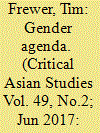|
|
|
Sort Order |
|
|
|
Items / Page
|
|
|
|
|
|
|
| Srl | Item |
| 1 |
ID:
121395


|
|
|
|
|
| Publication |
2013.
|
| Summary/Abstract |
We investigate the impacts of the U.S. renewable fuel standard (RFS2) and several alternative biofuel policy designs on global GHG emissions from land use change and agriculture over the 2010-2030 horizon. Analysis of the scenarios relies on GLOBIOM, a global, multi-sectoral economic model based on a detailed representation of land use. Our results reveal that RFS2 would substantially increase the portion of agricultural land needed for biofuel feedstock production. U.S. exports of most agricultural products would decrease as long as the biofuel target would increase leading to higher land conversion and nitrogen use globally. In fact, higher levels of the mandate mean lower net emissions within the U.S. but when the emissions from the rest of the world are considered, the US biofuel policy results in almost no change on GHG emissions for the RFS2 level and higher global GHG emissions for higher levels of the mandate or higher share of conventional corn-ethanol in the mandate. Finally, we show that if the projected crop productivity would be lower globally, the imbalance between domestic U.S. GHG savings and additional GHG emissions in the rest of the world would increase, thus deteriorating the net global impact of U.S. biofuel policies.
|
|
|
|
|
|
|
|
|
|
|
|
|
|
|
|
| 2 |
ID:
152197


|
|
|
|
|
| Summary/Abstract |
Cambodia’s mountainous northeastern province of Ratanakiri, which only twenty years ago was home to mainly indigenous minority groups largely focused on subsistence production, has undergone rapid ecological, social, and economic transformation. Deforestation and land alienation in the context of large-scale plantation agriculture, land speculation, and smallholder cash cropping have led to concerns that indigenous communities are being alienated from their land and not benefitting from economic changes. This has resulted in a significant number of NGO and government programs that attempt to protect and “empower” indigenous people, particularly women. This article examines a one-year research project which explored the relationship between indigenous women and land change in two indigenous villages. It discusses how indigenous women as well as Khmer and landless Cham immigrants have dealt with the commoditization of land and labor. It focuses on the differentiated way capitalist relations have pushed men, women, landless laborers, and increasingly wealthy landowners on increasingly divergent life trajectories. Compelled by donors to focus on gender and indigenous women as an object of governance, the NGO that directed this project struggled to keep up with the realities of capitalist relations on the ground.
|
|
|
|
|
|
|
|
|
|
|
|
|
|
|
|
| 3 |
ID:
109599


|
|
|
|
|
| Publication |
2011.
|
| Summary/Abstract |
Recently, an active debate has emerged around greenhouse gas emissions due to indirect land use change (iLUC) of expanding agricultural areas dedicated to biofuel production. In this paper we provide a detailed analysis of the iLUC effect, and further address the issues of deforestation, irrigation water use, and crop price increases due to expanding biofuel acreage. We use GLOBIOM - an economic partial equilibrium model of the global forest, agriculture, and biomass sectors with a bottom-up representation of agricultural and forestry management practices. The results indicate that second generation biofuel production fed by wood from sustainably managed existing forests would lead to a negative iLUC factor, meaning that overall emissions are 27% lower compared to the "No biofuel" scenario by 2030. The iLUC factor of first generation biofuels global expansion is generally positive, requiring some 25 years to be paid back by the GHG savings from the substitution of biofuels for conventional fuels. Second generation biofuels perform better also with respect to the other investigated criteria; on the condition that they are not sourced from dedicated plantations directly competing for agricultural land. If so, then efficient first generation systems are preferable. Since no clear technology champion for all situations exists, we would recommend targeting policy instruments directly at the positive and negative effects of biofuel production rather than at the production itself.
|
|
|
|
|
|
|
|
|
|
|
|
|
|
|
|
| 4 |
ID:
110495


|
|
|
|
|
| Publication |
2011.
|
| Summary/Abstract |
Grain self-sufficiency is one of the most important agricultural policy goals in China. With only modest imports, China has succeeded in feeding 22% of the world's population on only 7% of its land. However, a high price has been paid for this enormous achievement. Increase in grain yields, in particular in rice, as the main source of production growth, relied heavily on intensive use of physical inputs and increasing intensity of farming systems. Soil degradation, water scarcity, and severe pollution were among the consequences as well as declining efficiency of fertilizer application. Using county-level panel data from 1980 to 2003 and graphical (GIS-based) analysis, this paper first looks at the spatial change of the major grain production across regions over the past two decades, towards the northern and northeastern provinces. The analysis is complemented by using a random panel data model, which underscores the significant influence of land availability, degree of urbanization, and government policy on grain production. Finally, this analysis addresses environmental stress which includes both soil degradation and water shortage. The latter is already severe in many of the traditional grain producing areas, but will now become a bigger problem in the "new" grain producing areas, as these have traditionally much less water resources. Hence, while the economic rational of the "grain shift" towards the northern and northeastern regions is understandable, its sustainability is not guaranteed.
|
|
|
|
|
|
|
|
|
|
|
|
|
|
|
|
| 5 |
ID:
121266


|
|
|
|
|
| Publication |
2013.
|
| Summary/Abstract |
The use of biofuels can increase land competition, leading to global land use change (LUC). LUC poses risks such as increased greenhouse gas emissions and food prices. The magnitude of the risk is uncertain, but could be significant. Given these uncertainties and risks, we suggest that policymakers pursue a mix of the following three strategies: (1) promote feedstocks that rely less on land; (2) reduce LUC risk for land-using feedstocks; and (3) stimulate investments that increase land productivity and environmental protection. To realize these three strategies, we recommend that policymakers distinguish among feedstocks based on LUC risk; explore certifying production that avoids land competition; and adopt policy mechanisms that encourage investments in LUC-prone areas. We favor including feedstock-specific LUC emissions estimates in policies despite relatively large scientific uncertainty. While misleadingly precise, point estimates can be selected from science-based ranges to directly link LUC policy to emissions and provide strong transparent signals to biofuel investors. LUC emissions estimates can be updated regularly (~3-5 years) to reflect improvements in scientific understanding, and global changes in policy and economic environments. With or without LUC emissions point estimates, additional policies, some outside the biofuel sector, will be needed to pursue the three strategies above.
|
|
|
|
|
|
|
|
|
|
|
|
|
|
|
|
|
|
|
|
|